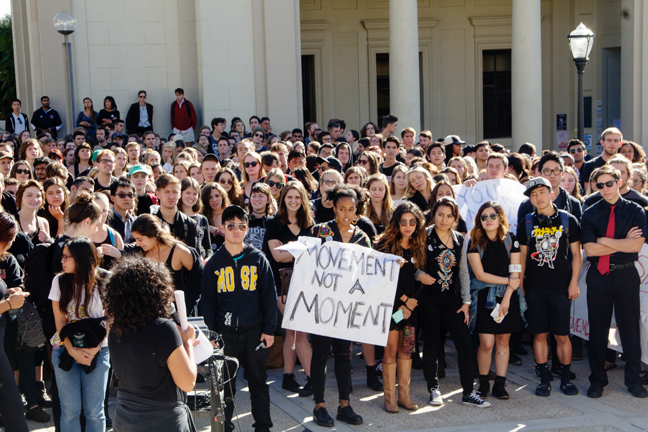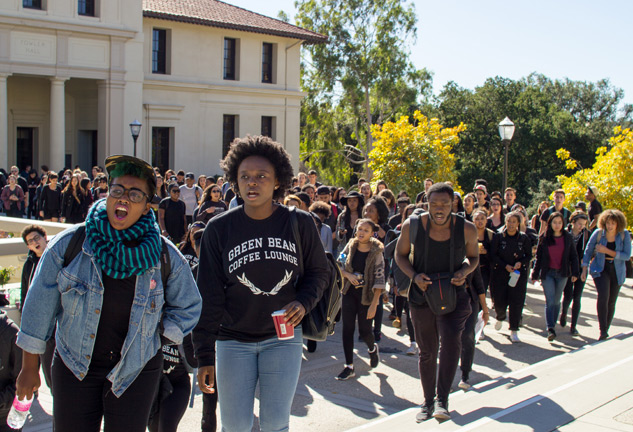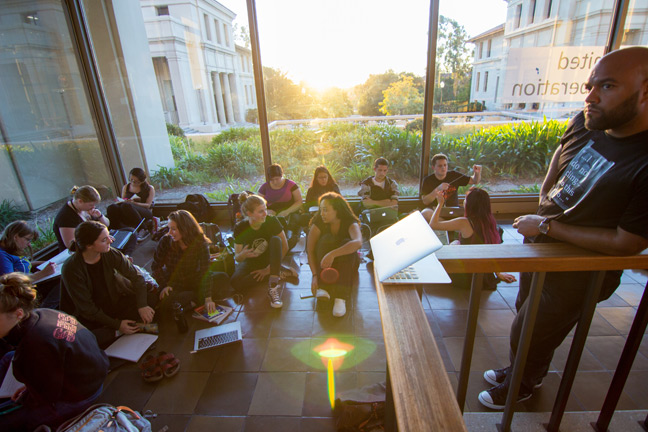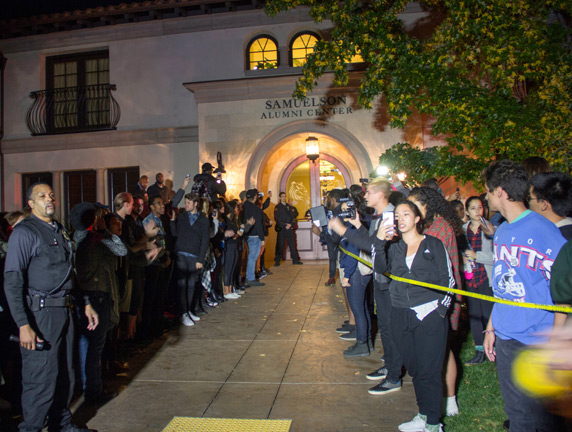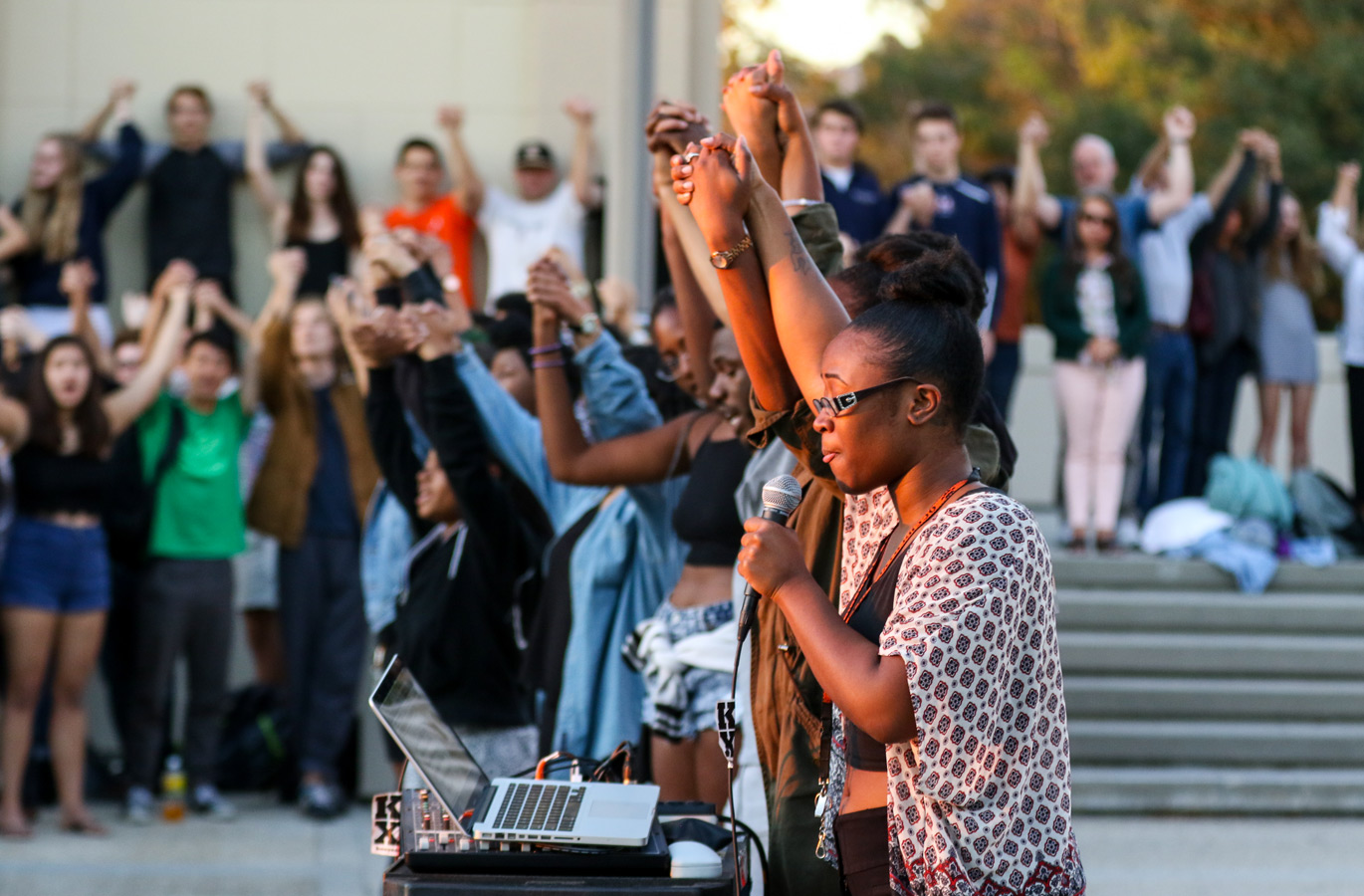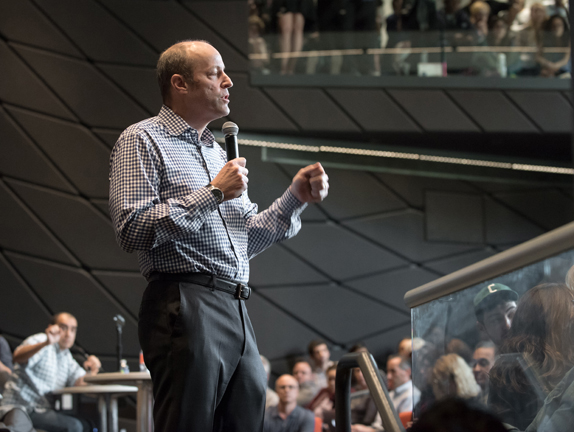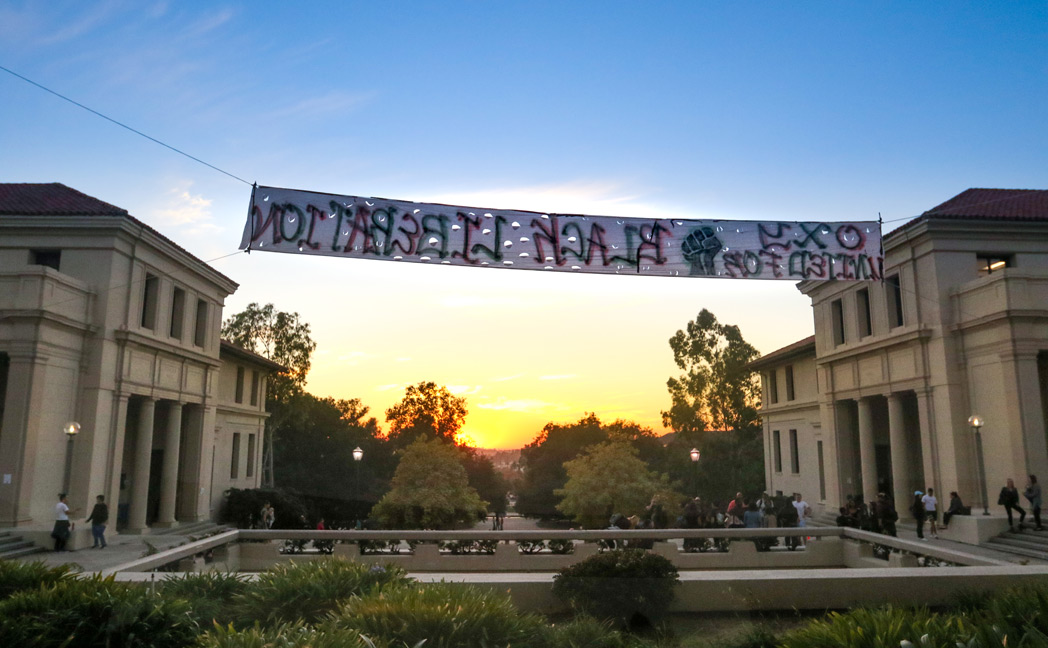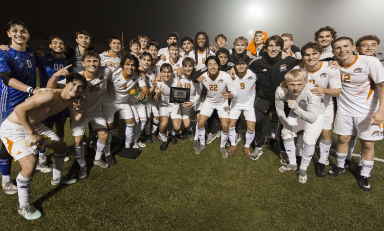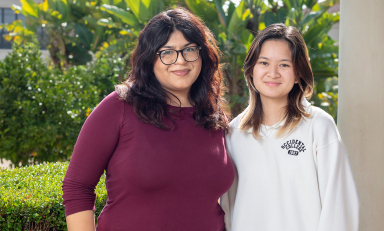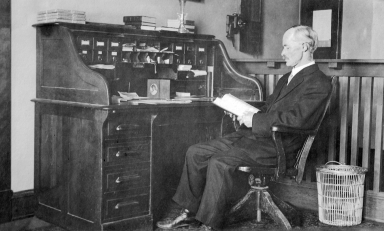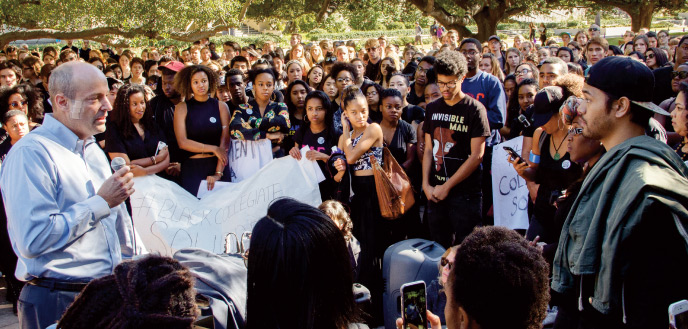
A long-simmering debate over diversity and equity at Oxy came to a boil in November, with hundreds of students demanding institutional reform. As a new semester dawns with the promise of change, can the campus heal and unite going forward?
Dating back to its dedication on May 27, 1968, the Arthur G. Coons Administrative Center has been at the nexus of student protest at Occidental. As Andrew Rolle '43 recounts in his centennial history of the College, "Students and a few faculty marched from the Quad to the new building bearing the slogans 'Money for Black,' 'This Building Offends Me,' and 'Dedicate People, Not Buildings.' The goal was to voice campus unrest and demand more decision-making power for students in the affairs of the College."
The dedication proceeded without incident, as demonstrators stood to the side and behind several hundred invited guests. ASOC president (and future Oxy trustee) Don Cornwell '69 declined President Richard C. Gilman's invitation to participate in the ceremony, writing: "I frankly do not care to share a platform with men and women who have gained their positions in life through the opposition of other humans … I may be president of the student body, but I am also a human being and a black man—to accept your invitation would demean myself." Three days earlier, Oxy's Black Student Caucus delivered a list of eight demands to the administration, including a call for the addition of four African American-centric classes to the curriculum.
A new chapter in that legacy of protest began on Nov. 12, 2015, following what's believed to be the largest student rally in the history of the College, in conjunction with a nationwide day of demonstrations following racially charged incidents at the University of Missouri, Yale University, Ithaca College, and Claremont McKenna College. At 11 a.m., some 200 students marched through the Quad up to Weingart chanting, "We are Oxy POC/We won't suffer silently," "White silence perpetuates violence," and "My neck, my back/Get the f*** out yo class."
Once they assembled in the Quad, black students were instructed to gather in the front and white students to move to the periphery. "We owe solidarity to the students at Mizzou and all black students nationwide," said an organizer for Oxy United for Black Liberation, a partnership between members of Oxy's Black Student Alliance and student and faculty members of the Coalition @ Oxy for Diversity and Equity (CODE).
The crowd continued to swell to about 500 as students of color shared personal accounts of microaggressions (defined by Columbia University professor Derald Wing Sue as "brief, everyday exchanges that send denigrating messages to certain individuals because of their group membership") on the Oxy campus: people assuming they were recruited for athletics, for instance, or that they got in because of affirmative action. "We're not protected here," one speaker said, while another added: "We are not thriving; we are surviving day by day."
Among the onlookers was President Jonathan Veitch, who was invited to address the crowd. "If you're not feeling safe, that's important to me," he said, adding, "I want everyone here to thrive and be successful. … Help me help you." Students presented him with a list of demands, from a renewed call for a black studies major and elevating the new chief diversity officer position to vice president level to doubling the number of faculty of color over five years and the "demilitarization" of Campus Safety. At the top of the list: Veitch's immediate resignation.
"This is not the place to address the demands," Veitch replied, to which one student replied, "This is not some casual conversation." The talk shifted to sexual assault on campus, with students shouting out names of alleged sexual predators, and the president walked away, he later explained, "because it seemed as if my presence was contributing to a deteriorating situation, and I felt that it was not productive."
It quickly became clear that the mantra adopted by Oxy United—"A Movement Not a Moment"—was more than sloganeering. After a pair of weekend demonstrations at Oxy's football and basketball contests, word quickly spread on Monday, November 16, of a noontime rally outside the AGC, and another sizable crowd appeared. While the protest might have been triggered by the nationwide activity that followed the Mizzou uprising, the debate over diversity and equity at Occidental was revisiting issues that had never been fully resolved.
From April 17 to 19, 1996, student protesters under the name of Empowerment Through Multiculturalism organized a sit-in in the Coons Administrative Center after the percentage of incoming freshmen of color slipped below 50 percent, accusing President John Slaughter and Oxy of straying from their commitment to diversity. (From 1998—the first year it measured student diversity—to 2001, U.S. News & World Report ranked Oxy No. 1 in diversity among 160 national liberal arts colleges.)
The most recent surge of activity dates back to the formation of CODE, which in October 2013 introduced an agenda titled 29 Actions to Achieve Equity and Excellence. On Nov. 14, 2013, students staged a "sit-out" outside Occidental's Interfaith Center in support of a petition signed by more than 250 faculty, students, and alumni to increase diversity and equity on campus. (That December, in response to CODE's concerns, Jorge Gonzalez, vice president for academic affairs and dean of the College, unveiled a 17-point action plan centered around building and sustaining a diverse community and enhancing the curriculum, improving the Oxy experience, and facilitating participation in high-impact academic and co-curricular experiences.)
In the time since, CODE kept a watchful eye on campus, protesting the LAPD's arrest of a local community member outside the Green Bean last September after a student employee contacted Campus Safety. Before that, there was an "End of the World Party: Malaysian Air-ISIS-Ebola" organized by members of Phi Kappa Psi fraternity for Halloween 2014. While the event was canceled, "By mocking and sexualizing these deaths, the participants of this party are making obvious whose lives matter and whose do not," CODE wrote on its Facebook page. (Following a public demonstration by CODE, the fraternity suspended the party's two organizers.)
And nine months before that, in February 2014, there was the desecration of the Trayvon Martin memorial—a package of Skittles and can of Arizona Iced Tea placed by students of color in the Quad with the words "Rest in Power Trayvon Martin" written in chalk to mark the two-year anniversary of Martin's shooting death by George Zimmerman in Sanford, Fla.
Two students "knowingly ate the Skittles and Arizona we put out, without any repercussions from administration," BSA president Diamond Webb '16, a sociology major from New York City, said at the November 16 rally outside AGC. "In retaliation, my black peer and I were falsely accused of assaulting one of the two students, and we were subsequently investigated. To be black at a PWI [predominantly white institution] means to be in a perpetual state of suffocation. I can't mourn the racially charged murder of a 17-year-old black boy who could have easily been my little brother. I have held my breath for far too long. We have held our breath for far too long."
In t his age of social media, the rules of engagement have changed for protest movements. On November 2, University of Missouri graduate student Jonathan Butler began a hunger strike for the removal of President Tim Wolfe over the school's handling of racial harassment issues. Student-athletes of color on Missouri's football team staged a walkout five days later. After Wolfe and the school's chancellor resigned November 9, the national wave of protests went viral.
Three days later, students at more than 100 colleges and universities staged rallies in support not only of the Missouri activists (#InSolidarityWithMizzou became a common hashtag), but also Yale, Ithaca, and Claremont McKenna, which were also embroiled in protests with administrators over handling of racial issues. (On November 13, CMC's dean of students stepped down—a move that has divided the Claremont community.)
It's not a stretch to say that Oxy United became part of that movement. Following a series of speeches critical of the College administration, Antoniqua Roberson '16, an urban and environmental policy major from Dorchester, Mass., revealed the November 16 rally's true purpose. "We'll, in fact, be occupying the AGC," she said to loud applause. "We are prepared to camp here—day in, day out, sunrise to sunset—until our demands are not only heard but actually met."
And with that, students marched into the AGC, chanting "Sixty-seven grand—meet our demands!" (the actual cost for attending Oxy in 2015-16: $63,194) and occupying every hallway and public space of the building's first and second floors. A handful of professors quickly rescheduled classes on site. Student Life administrators carried bottled water into the AGC, while a member of the president's cabinet ordered pizzas for the students that first night (as did Slaughter in 1996).
After a crowded but largely nondisruptive 24 hours, things took a turn on November 17 (Day 2 of the occupation). At 3 p.m., Oxy United organizers announced that students were to move into office space on the first floor of the AGC, displacing the work of many, from the business and financial aid offices to institutional advancement and human resources. The atmosphere intensified, as students knocked on locked office doors and administrators made the decision to evacuate the building.
For sheer drama, the high point of the occupation came on November 18 (Day 3). First, in the afternoon, students forced their way into the third floor of AGC and the office of the president and his staff, among others. This was Veitch's first face-to-face encounter with the protesters in six days, but his attempts to engage in a conversation were shouted down by a sound system blasting Rihanna's "B*tch Better Have My Money" whenever he attempted to speak. He and his staff subsequently evacuated the building, and occupants quickly papered the interiors and windows with flyers and signs.
Hours later, the tension ratcheted even higher, when visiting members of Black Lives Matter Los Angeles and organizers from USC, Cal State Long Beach, and other schools joined hundreds of Oxy protesters in surrounding Samuelson Alumni Center, banging on its doors and windows just before 8 p.m. They were intent on flushing out Veitch, who was inside preparing the College's response to Oxy United's demands with a group that included trustee John Power '58. "We needed to let them know there's no place to do work," Danielle Raskin '17, a UEP major from Brooklyn, told the Los Angeles Times. "We needed to show them that we're not going anywhere until our demands are met."As Campus Safety ushered more than a dozen other College employees out the back of the building, activists formed a human chain surrounding the property, refusing to let anyone leave. Finally their attentions were distracted by Veitch and his wife, Sarah, leaving the building after a fire department crew, responding to a medical call, taped off a path from the entrance to a waiting car. (LAPD was present as well.)
The episode was captured by a student videographer, boiled down to 35 seconds and quickly posted by CODE on YouTube, garnering more than 4,700 views. On Twitter and Facebook, #oxyuproar and #impeachveitch were popular hashtags as students, parents, alumni, and trolls engaged in dialogue that ranged from thoughtful to profane.
Reflecting the national awareness of the student uprisings, both traditional and new media flocked to campus to report on the Oxy United movement. (After two days at Oxy, Adelle Nazarian, a reporter for conservative-leaning Breitbart News, was kicked out of the AGC by students who claimed that she was violating their "safe space"; she recorded and posted the incident.)
Writing in the Huffington Post, Olivia Davis '17, a theater major from Los Angeles, called the movement "a manifestation of the daily microaggressions, discrimination, and other facets of marginalization we come to know as our college experience. … It is every day that I have to walk through this institution internalizing all of the psychic violence enacted on black students and students of color that makes me believe that I do not belong here."
On the outside of the movement, Alton Luke '18, a kinesiology major from Long Beach, was shunned by many of his friends and applauded by others when he posted his views of Oxy United on Facebook. "I'm not saying the movement is unjustified," wrote Luke, who is black, "but I'm not involving myself in a movement who has participants that consider me ignorant because I don't stand with them." On November 21, Luke found his picture on the front page of the Los Angeles Times as part of a story about campus critics of protest movements nationwide.
After repeated attempts to sit down with Oxy United representatives had been rebuffed, the College replied to the group's full list of demands on the morning of November 19 (Day 4). While reiterating the Board of Trustees' endorsement of President Veitch and noting that any changes to the curriculum require faculty action, specific responses addressed most of the demands. "While there remains significant work ahead, we believe we will best be able to accomplish it together," said a message signed by board chair Chris Calkins '67, Veitch, and Gonzalez.
Despite initially dismissing the College's overtures—"Oxy's systemic racism will not simply be fixed by saying you've listened to us or by creating a spreadsheet that does not offer mechanisms of accountability," Oxy United replied later that day—the group announced on November 20 (Day 5) that they would evacuate the AGC the following morning. "The occupation did not solve our problems, but what it did show us is that we [students] can work to bring change for ourselves as we mobilize for justice," said Abhilasha Bhola '16, a diplomacy and world affairs major from Redmond, Wash. "Y'all have made this space what it is: beautiful, empowered, revolutionary."
In an email November 23, Veitch reiterated the campus' collective responsibility to uphold freedom of expression and mutual respect: "Occidental must be a place where even if we disagree vigorously about the issues, we can respect and be civil with each other."
That test of civility extends to the Oxy faculty, who have clashed with the administration in recent years over its handling of the sexual misconduct issue, among other matters. At a November 19 emergency meeting, the faculty approved a resolution expressing "full support" for Oxy United's actions "and the demands for the culture around racism and diversity in the institution to change." That precipitated a November 24 special meeting to consider curricular and hiring implications of the agreement, as well as a potential vote concerning Veitch's leadership.
Dale Wright, the David B. and Mary H. Gamble Professor in Religion and a 35-year veteran of the faculty, expressed disappointment in the College's response to the crisis at a meeting December 1. Still, he opposed a vote to impeach the president, calling the potential outcome deeply harmful to the College and one that would impede the activists' demands. If the impeachment vote were to succeed, Wright noted, Occidental would not be able to go into a capital campaign, alienating students, alumni, and potential donors in doing so.
While a motion for Veitch to resign was defeated by an overwhelming majority of tenured and tenure-track faculty (83 to 45, with five abstentions), a number of professors who opposed the measure made it clear that their vote should not be misconstrued as support of the status quo—that a vote would put pressure on the administration to do better.
At a standing-room-only town hall in Choi Auditorium on December 3, Veitch reiterated his commitment to making Occidental "a diverse and committed community." "I care about you. Full stop," he told a somewhat contentious gathering of students. "I have focused on raising money for this institution at the cost of being present to the people in this room, and I own that."When asked what he would do personally to understand the campus climate that precipitated the protests, Veitch responded, "I am committed to self-reflection. … I'm going to read, I'm going to think, I'm going to talk to people that I respect and admire. I'm going to talk to students, faculty, and staff. And I'm going to listen."
There will be much to discuss this semester. On January 11, Veitch announced Rhonda Brown—former associate vice president for institutional diversity, equity advocacy, and leadership at Temple University—as Oxy's first vice president for equity and inclusion and chief diversity officer. Fulfilling specific demands, funding for diversity programs and support for the Intercultural Affairs office is in place, and advisory committees on campus safety and diversity and inclusion have been formed.
Meeting on campus January 24 and 25, the Board of Trustees approved going forward with Oxy's first major capital campaign in more than 20 years and elected Susan H. Mallory '76 M'78 to succeed Calkins as chair. Seventeen trustees met over lunch with three student groups, including CODE, to hear their concerns about campus life.
And when faculty reconvened in Lower Herrick for a daylong retreat January 19, they were joined unexpectedly by about 50 members of Oxy United for their afternoon session. As the semester progresses, faculty are expected to address two hot-button proposals: one "to develop an effective mechanism for students to address and report microaggressions or other conflicts between students and faculty," and a second that would require all departments to incorporate issues of cultural and racial identity and diversity into their curricula—from American studies and biochemistry to writing and rhetoric.
For staff and administrators, it will take some time to heal from the sense of feeling intimidated or one's personal space being disrespected. Many emotions surfaced during a pair of all-campus meetings—one held on Day 4 of the occupation, and the second on November 30. "Do you think [the protesters] have any sense of how they affected staff who they claim to be in solidarity with?" one AGC-based staffer asked President Veitch.
As for Oxy United, all expectations are that members will be monitoring closely the College's progress toward "a meaningful shift in culture." "Through this growth we our prepared to mobilize for the long term," Bhola said at the November 20 rally. "While we may no longer hold this building, we now have a responsibility to expand this occupation outward." In the words of Raihana Jacqueline Haynes-Venerable '17, a critical theory and social justice major from Chandler, Ariz., "Our occupation in the AGC is ending, but the movement is just beginning."
Samantha B. Bonar '90 contributed to this story. Photos by Cruz Riley '17 (Quad, AGC steps, Samuelson Alumni Center), César Martinez '17 (Olivia Davis '17, La Mont Terry '98), Jeremy Bloom '17 (Antoniqua Roberson '16, banner), and Marc Campos (Veitch).
To read more about the Oxy United movement, visit oxyunited.com. To read more from the administration's perspective, visit oxy.edu/news/oxy-student-protest-updates.

